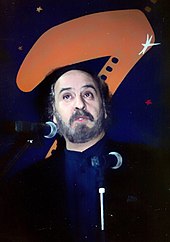Miguel Littín
Miguel Ernesto Littín Cucumides (born August 9, 1942 in Palmilla , Chile ) is a Chilean director , film producer and writer of Palestinian origin.
Life
Filmmaker Miguel Littín began his career in 1965 with his debut film Por la tierra ajena . His first internationally known work was the reconstruction film El chacal de Nahueltoro (German: The Jackal of Nahueltoro ), produced in 1969 at the Universidad de Chile with Luis Cornejo Gamboa , which deals with the authentic case of a murderer executed in Chile in 1963. The film was shown at the Berlinale 1970 .
In 1971 Littín made the film La Tierra prometida (German: The Promised Land ): a film about unemployed farmers around 1930 who are looking for the promised land. It was banned in 1973 after the military coup in Chile . As an exposed supporter of the ousted President Salvador Allende , Miguel Littín had to leave Chile during the military dictatorship under Augusto Pinochet and went into exile in Mexico . Littín made many films there that deal with the dictatorship in Chile.
In addition to his cinematic work, Miguel Littín is also active as a writer and has written two novels. His role model, the Chilean writer Francisco Coloane , and his love for Tierra del Fuego play a major role. Littín's film Tierra del Fuego ("Tierra del Fuego") from 2000 is about the fate of gold prospectors in Tierra del Fuego.
The film Acta General de Chile
In 1985 Littín started his most famous and spectacular film project, Acta General de Chile . His plan was to shoot a documentary in the middle of Chile, even though the country was closely monitored by the secret police . Littín planned this risky undertaking like a military man. The film was disguised as a commercial and Littín changed its appearance a lot. He assumed the identity of a Uruguayan . Since his team also consisted of many Europeans and other foreigners, Littín succeeded in what was hardly thought possible: past Pinochet's secret police, his recordings took a deep look into life under the dictatorship. Littín filmed in Chile for around six weeks. Around 32,000 meters of film were recorded during this time.
The film is divided into four sections:
- Littín illegal in Chile
- Location in the mining region in northern Chile
- Travel to the center of Chile
- Homage to Allende and Chilean oppositionists
The last part includes tributes to Gabriel García Márquez , Fidel Castro and Hortensia Bussi .
The writer Gabriel García Márquez described the creation of the documentary in his report The Adventure of Miguel Littín . In it he let Miguel Littín retell the “incredible story” personally.
Filmography
|
|
literature
Gabriel García Márquez : The Adventure of Miguel Littín . Fischer-Verlag, Frankfurt / M. 2004, ISBN 3-596-16257-2 .
Web links
- Miguel Littín in the Internet Movie Database (English)
| personal data | |
|---|---|
| SURNAME | Littín, Miguel |
| ALTERNATIVE NAMES | Littín Cucumides, Miguel Ernesto (full name) |
| BRIEF DESCRIPTION | Chilean director, producer and writer of Palestinian origin |
| DATE OF BIRTH | August 9, 1942 |
| PLACE OF BIRTH | Palmilla , Chile |
